
What are bloggers’ biggest challenges, processes, and goals in 2017? What are the trends that bloggers need to be paying attention to in 2018?

Every year for the last four years, the wonderful Andy Crestodina has been on a quest to answer these questions in his blogger survey. I met Andy a number of years ago at a social media event, and we became fast friends. In fact, one of the weddings I was invited to actually listed “Jess Ostroff & Andy Crestodina” on the invitation because we had so many pictures together on Facebook and the bridesmaid at the wedding got confused about who my boyfriend was. (His name is also Andy—easy mistake to make.)
But I digress.
This year, an impressive 1,377 bloggers answered the call to provide their insights. That’s a lot of bloggers! I’m not surprised, given Andy’s charm and smarts. He is a true data nerd, and I can say for myself that the reason I spent the time filling out the survey was that I knew the output would be interesting, useful, and perhaps even inspiring.
I was right.
Behold: Five major takeaways from the 2017 blogger survey. And please do yourself a favor and download the full survey for more delicious insights. You won’t be disappointed in the time, energy, and work that went into analyzing this data!
1. Writing Time Increases, Publishing Frequency Decreases
Despite the fact that videos, Stories, and Snaps are growing in popularity, it’s clear from these 1000+ bloggers that writing still matters. (Thank goodness!) Bloggers are spending more time than ever crafting high-quality pieces. But the number of hours in the day remains the same, which means that something has to give.
It’s no longer about publishing 500-word articles every day to keep people’s RSS readers topped up. Instead, more and more bloggers are moving to a once or twice per week strategy. Many are culling it back even more to a few times per month.
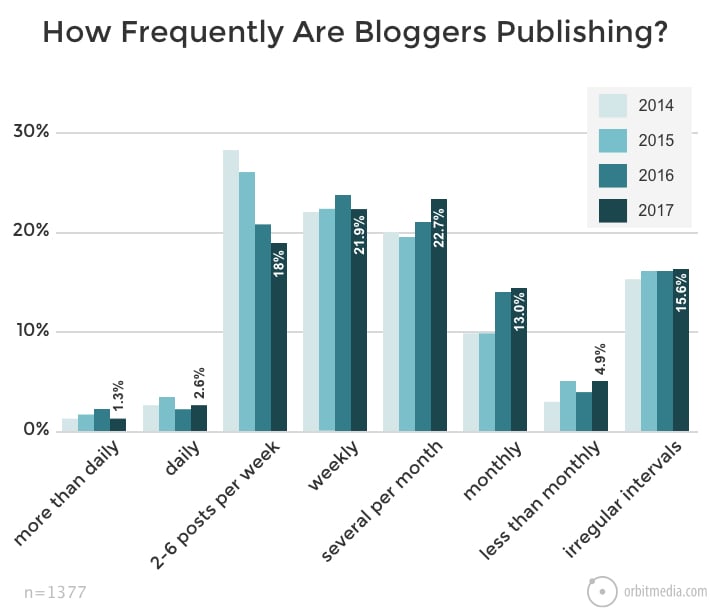
In 2014, almost 40 percent of bloggers said they were knocking out posts in one to two hours. But when I look back at the content I published in 2014, I can tell you with a straight face that it wasn’t very good. It sounds like other bloggers are reflecting and finding the same results. We didn’t spend enough time researching, looking for unique snippets of information, or injecting our own perspective.
From 2014 to now, I’d argue that many of us were creating content for the sake of content instead of for results. Now, finally, we are taking into account what our audience wants and how blogging fits into our overall digital marketing strategy.
According to the report, the average blog post takes a whopping three hours and 20 minutes to write. I’m definitely on the longer side—closer to five or six hours per post—especially if you include the time I spend brainstorming in the shower.
This tells me that even if your entire job is creating blog content, the average writer can’t really create more than one or two posts per day, let alone go through the editorial process of editing, graphics-creation, and promotional strategy to get those posts published as quickly.
So that explains the decrease in publishing frequency, but is less really more? According to these bloggers, the answer is, “Perhaps.” 49 percent of bloggers say that spending more time on each post does make a difference in the results they get from those posts.
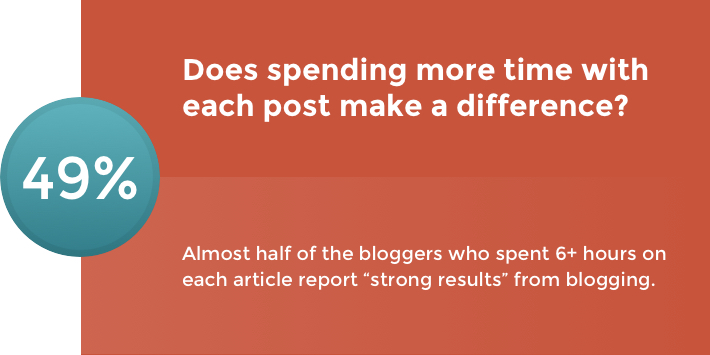
However, this is not a conclusive finding because bloggers also find a correlation between frequency and success.
This begs the question: How can we keep up with the demand to create more when we don’t have more resources, more budget, or more talent to produce at a high level?
In my humble opinion, if you are stuck with the decision about whether to create more content to keep up with frequency demands or better content with less frequency, creating less content that is of better quality and is more suited to your audience’s needs is the best option.
Ann Handley, author of Everybody Writes, agrees:
“The bigger themes here are two. One: Quality matters. And two: We don’t need more content. We need more relevant content.”
Relevancy is the killer app, and writers are reaping the rewards of spending more time making fewer pieces of content better, not creating more pieces that suck.
The average blog post takes a whopping 3 hours and 20 minutes to write. Click To Tweet2. Quality and Media Matter More Than Ever
When I saw the figure that says that bloggers who have a formal process for edits are 43 percent more likely to report strong results, I did a happy dance.

This goes back to the point I mentioned earlier about timing, however, because adding an editor into the process increases the overall time spent on a blog post. And it’s still true that the majority of bloggers edit their own work instead of going through a formal editing process, but the numbers are slowly rising, so I’ll keep dreaming about the day when all content creators use editors—because it truly does make a difference. After all, no one likes reading blog posts that are riddled with typos, and a poorly written article decreases your credibility as a thought leader.
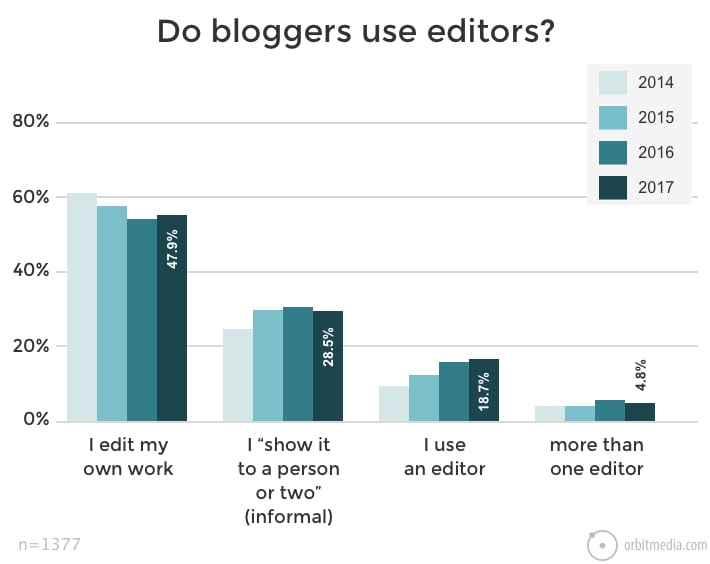
In addition to the conversation around quality, bloggers are also experimenting with including other types of media within their written pieces of content. Most bloggers are adding more images to their posts, which helps break up the text and provides a visual element for those of us who like to skim.
When it comes to other forms of media, such as audio and video, I found it interesting that the biggest percentage of bloggers are seeing strong results from including audio in their content.
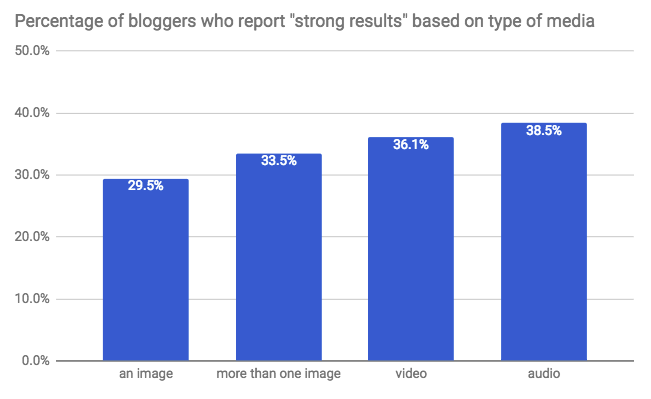
I believe this is related to the increasing number of podcasters out there and may also be related to including an audio reading of the blog post itself, which we have done here on Convince & Convert. People love to have different avenues for consuming content, and audio has proven to be a great one because it allows listeners to multitask while learning.
Still, the most common form of media used among bloggers is images, and 30 percent more bloggers are using multiple images to draw readers into their posts. This increasing use of media is paying off, with the bloggers who do use video, audio, and graphical elements reporting strong results.
3. Long-Form Articles Are Winning
As you may have guessed, while bloggers are spending more time on each post, they aren’t spending more time writing the same amount of words. Blog posts are getting longer. They are trending toward the long-form, 2,000+ word posts.
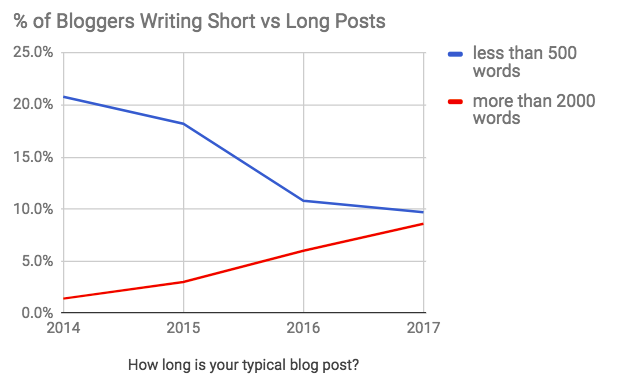
At Convince & Convert, we’ve seen the positive results that are associated with longer form content. That’s because readers these days are looking for a one-stop shop of information. They don’t want to scour through a bunch of 250-word articles when they can skim through one 3,000 word article to find the answers they need.
Bloggers from this survey agree. In fact, over half of them report strong results when a post is 2,000 words or more.
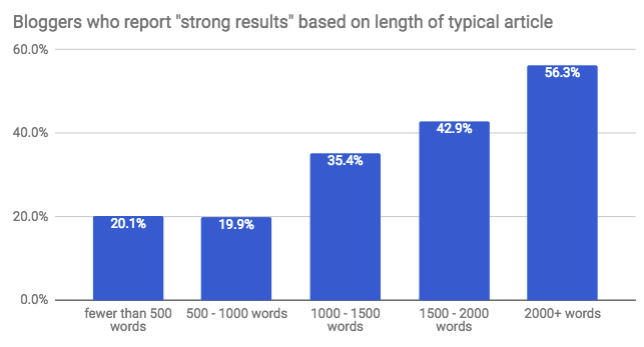
Today, the average blog post is 1,142 words long, which is 41 percent longer than the average post just three years ago. Plus, six times as many bloggers are writing 2,000+ word posts—six times! It’s no wonder bloggers are spending more time than ever on writing.
I’d be willing to wager that the average word count will increase next year after seeing that longer form posts drive better results. Would you agree?
4. Paid Promotion Plus Influencer Marketing Equals Content Promotion Success
It’s not surprising that using paid advertising tactics to promote blog posts wasn’t very popular in 2014. Back then, social media ad platforms were in their infancy (or non-existent), and most people didn’t know how to leverage them effectively.
Facebook, Twitter, Instagram, and Pinterest have made it easy for anyone to become an advertiser. Combine that with the fact that organic reach continues to decline, and the insane spike in the usage of paid services is hardly a mystery.
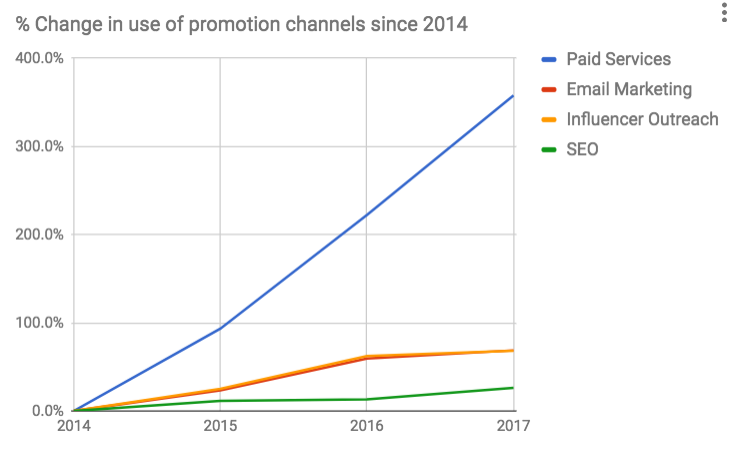
According to the survey, paid content promotion has seen a 5X increase since 2014. If this increase in usage continues, we will see half of all bloggers using paid services within the next four years.
Part of the reason paid services are so attractive right now is because their reporting tools help us justify the spend in ways that most other promotional tactics do not. It’s always about proving effectiveness, measuring content marketing efforts against goals, and reaching audiences where they are. Paid advertising services that provide targeted, specific options allow us to do just that.
And while none of the other promotion tactics compared to the massive rise in paid services, influencer outreach has seen its own success over the last couple of years as well.
It’s interesting to note that while influencer outreach is not the most popular form of promotion, it is reported to be one of the most effective. Almost half of bloggers who are collaborating with influencers are seeing strong results.
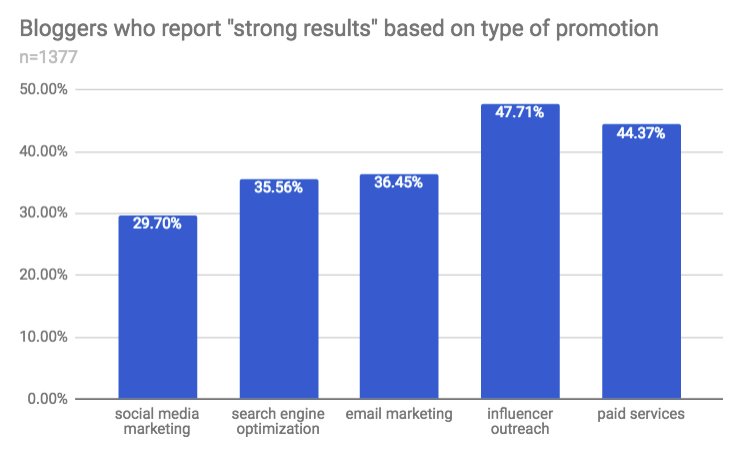
That’s compared to only about 30 percent from social media marketing, even though social media marketing is by far the most widely used tactic for promotional efforts.
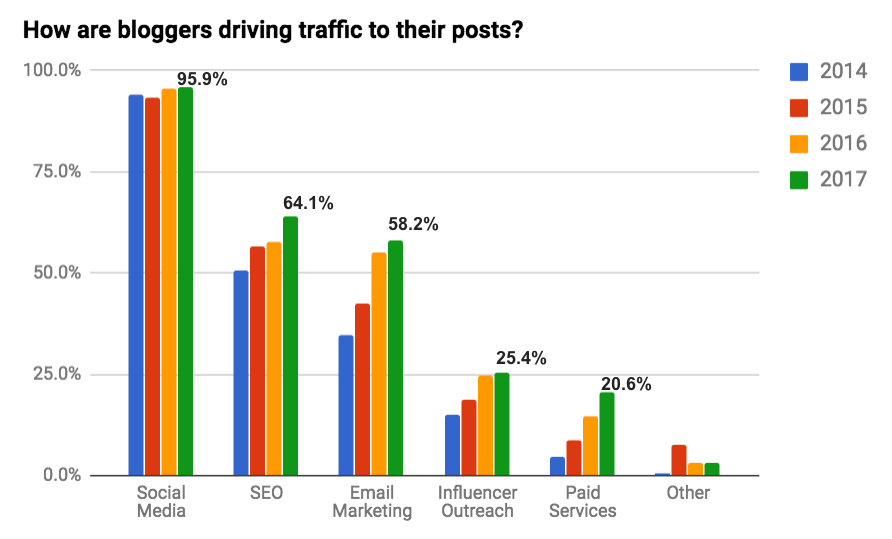
Remember: Just because things like tweeting or sharing a Facebook post are easy doesn’t mean they work. This research suggests that you may benefit more from investing your time and resources in the tactics that are harder but provide better results.
5. Updating Old Posts Is a Worthwhile Strategy
Although only 55 percent of bloggers are updating older posts with new information and links, 74 percent of those bloggers are reporting strong results. This means that the ones who aren’t doing this may simply not know what they’re missing!
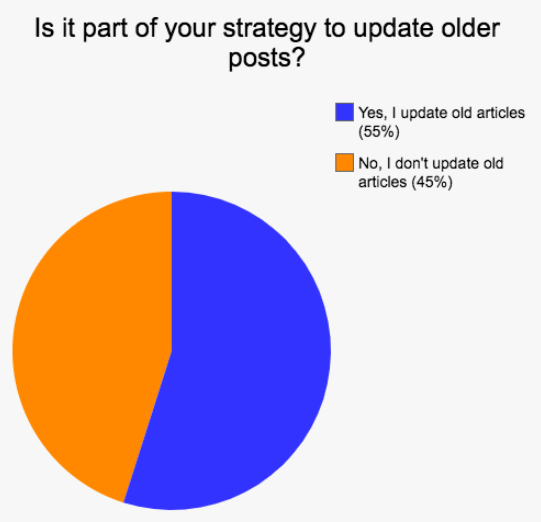
I could go on and on about the reasons why updating old content is so important. Here are just a few reasons:
- It allows you re-use content you’ve already spent lots of time and energy on.
- It signals to Google that you’re maintaining popular content.
- It tells your readers that you care about them because you’re consistently providing them with useful information.
Here at Convince & Convert, we have implemented a new strategy where we go through our most popular blog posts based on Google Analytics and update the top 10 posts every quarter. If the top 10 are the same for the next quarter and there are no new updates to make to those particular posts, we move on to the top 20, and so on.
This allows us to continue ranking for the terms that people are searching for and providing them with the information they need.
Lisa Jenkins from Social Media Examiner started using this strategy when she noticed that visitors continued to find and click on older articles through Google, but bounce rates were increasing. Starting with those articles is a great step toward developing an ongoing update strategy that works.
Just remember: “While you can update the text and should include a date stamp at the top of the article to show readers when the last update occurred, you should never change the original URL, or you’ll lose all that search juice,” Lisa cautions.
Bottom Line: Blogging (Still) Works
I might argue that “blogging” is out and “content marketing” is in. This is because bloggers aren’t just writers anymore—they’re strategists, editors, promoters, and data analysts. It’s not enough to spend hours writing a piece of content. The success of bloggers’ creations lies in the quality, relevancy, and promotion.
And as bloggers evolve into content marketers, their success evolves with them. From 2016 to 2017, 20 percent more bloggers report strong results from their blogging efforts.
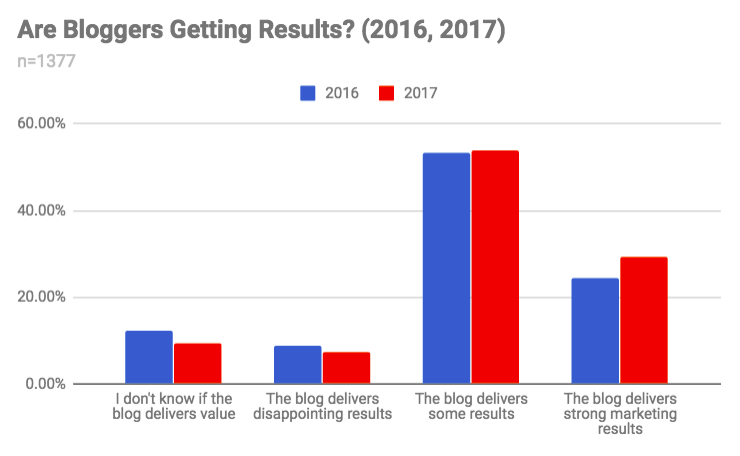
Yes! This is encouraging, especially for those of us who are still camera-shy or are not excited about all the Snap-stagram madness. If we keep investing our energy in writing, hiring the right editors, and putting our sights on the promotion engines that produce the highest ROI, we will all be just fine.
Don’t forget to download the full report here. Thanks to Andy and his team for pulling together this helpful research year after year.

